Description
Made of 3 µm silica particles, Zenix SEC packing is a breakthrough technology for size exclusion chromatography.
Combination of 3 µm silica particle size and proprietary surface technology enables highest separation efficiency
and resolution for biological molecules and water soluble polymers. Available pore sizes of Zenix packings are
100, 150 and 300Å.
Sepax SEC Product Family Comparison Chart
| Product Line |
SRT® |
Zenix™ |
SRT®-C |
Zenix™-C |
| Particle size |
5 µm |
3 µm |
5 µm |
3 µm |
| Pore size (Å) |
100, 150, 300, 500, 1000 & 2000 |
80, 100, 150, 300 |
100, 150, 300, 500, 1000 & 2000 |
80, 100, 150, 300 |
| Resolution |
High |
Highest, Short column for faster separation |
High |
Highest, Short column for faster separation |
| Efficiency |
High |
Doubled from 5µm |
High |
Doubled from 5µm |
| Selectivity |
Same for SRT® and Zenix™ |
Same for SRT®-C and Zenix™-C |
| Surface structure |
Chemically bonded stand-up monolayer |
Chemically bonded lay-down monolayer |
| Recommended Sample Types |
Monoclonal antibodies, proteins, peptides, nucleic acids, oligonucleotides, virus, and water-soluble polymers |
"Tough samples" such as hydrophobic proteins like insulin, membrane protein monoclonal antibodies derivatized with polymer branches, e.g. polypeptide, PEG. |
Packing
Zenix S
EC Technical Specifications
|
Phase
|
Zenix SEC-80
|
Zenix SEC-100
|
Zenix SEC-150
|
Zenix SEC-300
|
|
Material
|
Neutral, hydrophilic film bonded silica
|
|
Particle size
|
3 µm
|
|
Pore size
|
~ 80 Å
|
~ 100 Å
|
~ 150 Å
|
~ 300 Å
|
|
Protein MW range (native)
|
100 - 50,000
|
100 - 100,000
|
500 - 150,000
|
5,000 - 1,250,000
|
|
pH stability
|
2 - 8.5 (pH 8.5-9.5 can be tolerated temporarily.)
|
|
Backpressure (psi for a 7.8×300 mm)
|
~ 1,500
|
~ 1,500
|
~ 1,500
|
~ 1,500
|
|
Maximum backpressure (psi)
|
~ 4,500
|
~ 4,500
|
~ 4,500
|
~ 3,500
|
|
Salt concentration range
|
20 mM - 2.0 M
|
|
Maximum temperature (°C)
|
~ 80
|
|
Mobile phase compatibility
|
Aqueous and organic
|
Characteristic
o Particle size of 3 µm
o Selection of pore size: 80, 100, 150 and 300 Å
o Highest separation efficiency and resolution
o High loading capacity
o High stability over low and high concentration salt
o Lot-to-lot reproducibility
o High protein recovery with intact biological activity
o Negligible non-specific interactions
o Ideal for separation and analysis of biological molecules: proteins, nucleic acids, oligonucleotides,
peptides and virus
o Ideal for separation and analysis of natural polymers, e.g. polysaccharides, synthetic polymers,
and nanomaterials, e.g. nanoparticles
| Conditions |
|
| Column: |
Zenix SEC-300 (3 µm, 7.8×300mm) |
| Mobile phase: |
150 mM phosphate buffer, pH 7.0 |
| Flow rate: |
1.0 mL/min |
| Temperature: |
Ambient |
| Detector: |
UV 214 nm |
| Injection volume: |
5 µL |
| Sample: |
1. Thyroglobulin (1.0 mg/mL), 670 kD
2. BSA dimer, 132 kD
3. BSA (1.0 mg/mL), 66 kD
4. Ribonuclease A (1.0 mg/mL), 13.7 kD
5. Uracil (0.1 mg/mL), 120 D |
|
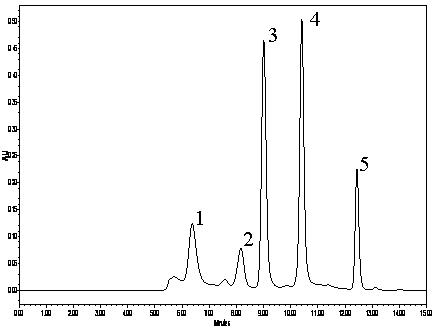 |
Pore size vs. MW exclusion limit
| Phases (3 µm) |
Pore Size |
Protein MW Exclusion Limit |
| Zenix SEC-80 |
80 Å |
50,000 |
| Zenix SEC-100 |
100 Å |
100,000 |
| Zenix SEC-150 |
150 Å |
150,000 |
| Zenix SEC-300 |
300 Å |
1,250,000 |
Column Dimension Availability
Available Zenix SEC column dimensions are 0.75, 1.0, 2.1, 3.0, 4.6, 7.8, 10, 21.2 and 30 mm I.D., and 20, 30, 50, 100, 150, 250, 300 and 600 mm length. Sepax also offers custom-made columns. Both stainless steel and PEEK tubes are available.
High Separation Efficiency
The advantages of developing small particle size are higher efficiency and higher resolution. When particle size is decreased to 3 µm from 5 µm, the column efficiency is almost doubled. As shown in Table 1, the plate numbers of BSA dimmer, BSA, ribonuclease A increased from 2720 to 4600, 6590 to 13090, 11160 to 22000 when the particle size decreased from 5 µm to 3 µm. Fig. 2 and Fig. 3 further show that high efficiency has been achieved by 3 µm Zenix columns with various proteins. The efficiency of p-aminobenzoic acid reached to the plate number of 40,000 for 30 cm long Zenix column.
Figure 1. Separation of protein mixture A by Zenix SEC-300 and SRT SEC-300 columns.
| Conditions |
|
| Column: |
Zenix SEC-300 and SRT SEC-300 |
| Mobile phase: |
150 mM phosphate buffer, pH 7.0 |
| Flow rate: |
1.0 mL/min for 7.8×300mm, 0.35 mL/min for 4.6×300mm |
| Temperature: |
Ambient |
| Detector: |
UV 214 nm |
| Injection volume: |
10 µL for 7.8×300mm, 3 µL for 4.6×300mm |
| Sample: |
1. Thyroglobulin (1.0 mg/mL), 670 kD
2. BSA dimer, 132 kD
3. BSA (1.0 mg/mL), 66 kD
4. Ribonuclease A (1.0 mg/mL), 13.7 kD
5. Uracil (0.1 mg/mL), 120 D |
|
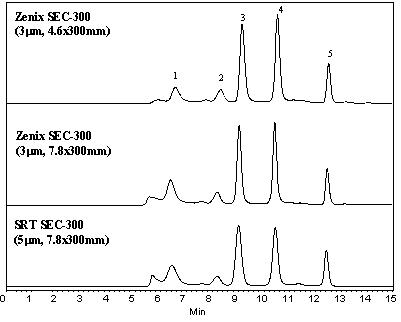 |
Table 1. Efficiency of Zenix SEC-300 and SRT SEC-300 columns.
| Peak |
Protein |
Zenix 300 (4.6×300) |
Zenix 300 (7.8×300) |
SRT 300 (7.8×300) |
| 1 |
Thyroglobulin |
2180 |
1730 |
1120 |
| 2 |
BSADimer |
4390 |
4600 |
2720 |
| 3 |
BSA |
10280 |
13090 |
6590 |
| 4 |
Ribonuclease A |
16490 |
22000 |
11160 |
| 5 |
Uracil |
33640 |
38500 |
27860 |
Figure 2. Separation of protein mixture B by Zenix SEC-150 and 300 columns with 7.8 mm ID.
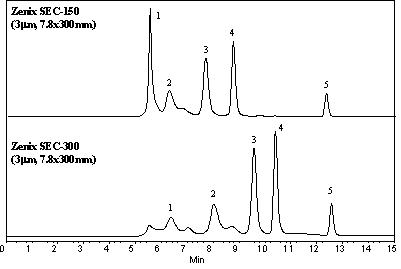 |
| Conditions |
|
| Column: |
3 µm, 7.8×300mm |
| Mobile phase: |
150 mM phosphate buffer, pH 7.0 |
| Flow rate: |
1.0 mL/min |
| Temperature: |
Ambient |
| Detector: |
UV 214 nm |
| Injection volume: |
10 µL |
| Sample: |
1. Thyroglobulin, 670 kD
2. γ-Globulin, 158 kD
3. Ovalbumin, 44 kD
4. Ribonuclease A, 13.7 kD
5. p-Aminobenzoic acid, 137 D
|
|
Table 2. Efficiency of 7.8×300 mm Zenix SEC-150 and 300 columns.
| Peak |
Protein |
Zenix 150 |
Zenix 300 |
| 1 |
Thyroglobulin |
12420 |
1295 |
| 2 |
γ-Globulin |
2860 |
3650 |
| 3 |
Ovalbumin |
6620 |
11760 |
| 4 |
Ribonuclease A |
16450 |
21690 |
| 5 |
p-Aminobenzoic acid |
40550 |
39400 |
Figure 3. Separation of protein mixture B by Zenix SEC-150 and 300 columns with 4.6 mm ID.
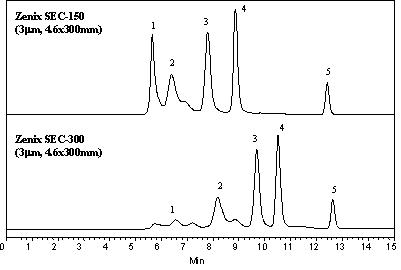 |
| Conditions |
|
| Column: |
3 µm, 4.6×300mm |
| Mobile phase: |
150 mM phosphate buffer, pH 7.0 |
| Flow rate: |
0.35 mL/min |
| Temperature: |
Ambient |
| Detector: |
UV 214 nm |
| Injection volume: |
5 µL |
| Sample: |
1. Thyroglobulin, 670 kD
2. γ-Globulin, 158 kD
3. Ovalbumin, 44 kD
4. Ribonuclease A, 13.7 kD
5. p-Aminobenzoic acid, 137 D
|
|
Table 3. Efficiency of 4.6×300 mm Zenix SEC-150 and 300 columns.
| Peak |
Protein |
Zenix 150 |
Zenix 300 |
| 1 |
Thyroglobulin |
6020 |
2410 |
| 2 |
γ-Globulin |
2560 |
3000 |
| 3 |
Ovalbumin |
6030 |
10260 |
| 4 |
Ribonuclease A |
13350 |
17020 |
| 5 |
p-Aminobenzoic acid |
35500 |
33480 |
High Loading Capacity
Loading capacity is critical for size exclusion separation and purification. Figure 4 shows high loading capacity for BSA as one example (>500 µg for an analytical column).
Figure 4. BSA loading test on a Zenix SEC-150 column.
 |
| Conditions |
|
| Column: |
Zenix SEC-150 (3 µm, 7.8×300 mm) |
| Mobile phase: |
150 mM phosphate buffer, pH 7.0 |
| Flow rate: |
1.0 mL/min |
| Temperature: |
Ambient |
| Detector: |
UV 214 nm |
| Injection volume: |
10 µL |
|
Figure 5. BSA loading test on a Zenix SEC-300 column.
| Conditions |
|
| Column: |
Zenix SEC-300 (3 µm, 7.8×300 mm) |
| Mobile phase: |
150 mM phosphate buffer, pH 7.0 |
| Flow rate: |
1.0 mL/min |
| Temperature: |
Ambient |
| Detector: |
UV 214 nm |
| Injection volume: |
10 µL |
|
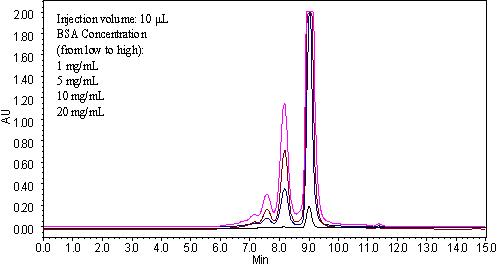 |
High Stability
The proprietary stationary phases of Zenix SEC packings utilize densely bonded chemistry on the silica surface, which greatly hinders the diffusion of the molecules that would attack the bond of silica-stationary phase layer, thus enabling high stability over a wide range of pH from 2 to 8.5.
| Conditions |
|
| Column: |
Zenix 3 µm, 7.8×300 mm |
| Mobile phase: |
150 mM phosphate buffer, pH 7.0 |
| Flow rate: |
1.0 mL/min |
| Temperature: |
Ambient |
| Injection volume: |
10 µL |
| Sample: |
A) BSA
B) Thyroglobulin (1.0 mg/mL)
BSA (1.0 mg/mL)
Ribonuclease A (1.0 mg/mL)
Uracil (2.5 mg/mL) |
Mobile Phase Compatibility
Zenix SEC phases are compatible with most aqueous buffers, such as ammonium acetate, phosphate, trizma and so on. Zenix SEC phases can tolerate high concentration of salts, such as 2.0 M. Furthermore, Zenix SEC columns are stable in both organic solvents, such as methanol, ethanol, THF, DMF, DMSO, and so on; as well as the mixture of water and organic solvents.
Lot-to-Lot Reproducibility
The controlled surface chemistry used to synthesize Zenix SEC phases makes the surface coating highly reproducible, leading to consistent column manufacturing. Separation variation from batch to batch is controlled to be within 5% for retention time.
| Conditions |
|
| Column: |
Zenix SEC-300 (3 µm, 7.8×150mm) |
| Mobile phase: |
150 mM phosphate buffer, pH 7.0 |
| Flow rate: |
1.0 mL/min |
| Temperature: |
Ambient |
| Detector: |
UV 214 nm |
| Injection volume: |
10 µL |
| Samples: |
1) Thyroglobulin, 2) BSA dimer, 3) BSA, 4) Ribonuclease A, 5) Uracil |
High Protein Recovery
Zenix SEC phases are hydrophilic and neutral. Proteins and other biological molecules have negligible nonspecific interactions with Zenix stationary phases. The protein adsorption to the silica surface is suppressed, leading to high recovery of intact proteins, maintaining the protein activity after separation. More than 95% recovery is achieved for BSA and lysozyme, the representatives for acidic and basic proteins, respectively. bio-equip.cn Profile
Sepax Technologies, Inc., a privately held company, was founded in Delaware, USA in November 2002. It develops and manufactures HPLC consumables, bulk media, and equipment in liquid chromatography for chemical and biological separations. It is a fast growing technology company and owns patents, proprietary technologies and know-how. Sepax has emerged as a leader in the biological separation industry in the global market.
Business strategies
Sepax Technologies, Inc. develops innovative HPLC consumables, bulk media, and instruments to solve separation challenges in the global market. We provide solution-based products by closely working with our customer scientists in pharmaceuticals, biopharmaceuticals, research institutes and government labs. Our strong technical team develops various methods with our customers to analyze complex biological molecules. As a leader in the biological separation industry, we constantly develop the best bio-separation technologies and products for our global customers. We have reached a competitive position globally in fast growing regions.
Vision Statement
To become a technology leader in the biological separation industry in the global market and provide solution based products and services for our customers.
Operation
Sepax Technologies, Inc.
Our company headquarter in Delaware is located in Delaware Technology Park with facilities of 15,000 ft2 dedicated to the development of separation resin technologies and instrumentation, production of HPLC resins, columns and CE consumables. It is also the marketing and sales center for our US and global markets.
Sales
Domestic
Audrey Fisher
Field Sales Account Manager
(Northern CA areas, UT, CO, OR)
Direct Phone: 925-324-5223
Email: afisher@sepax-tech.com
Kathleen Falls
West Coast Regional Manager
(All other CA areas, WA, TX, AZ, NM, MI)
Direct Phone: 323-228-0004
Email: kfalls@sepax-tech.com
Michael Hunnewell
Field Sales Account Manager
(MA, RI, NH, CT, NY)
Direct Phone: 302-650-3955
Email: mhunnewell@sepax-tech.com
Colleen Callahan
Midwest Account Manager
(WI, IL, IN, OH, MO)
Direct Phone: 302-366-1101, ext 106
Cell Phone: 302-339-8747
Email: ccallahan@sepax-tech.com
All other areas, please contact
Helen Gu
Vice President, Sales
Direct phone: 302-650-3909
Email: hgu@sepax-tech.com
International
Tingting Wu
Executive Account Manager/Marketing
Phone: 302-366-1101, ext 115
Email: twu@sepax-tech.com
|